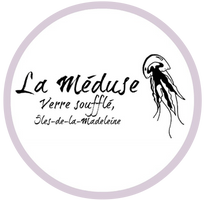
OUR DUO
At La Méduse, our work team is mainly made up of two people: Sophie Bourgeois and Catherine Chevrier-Turbide. They are two young women artists and co-owners of the company who love creating and working. They are always there to meet you!

SOPHIE BOURGEOIS
organic
Sophie completed technical training in crafts, with a specialization in ceramics in Quebec in 1996. She then began higher studies in crafts (pottery) in Halifax the same year, training which she continued until 1998 Always familiar with the field of art and manual by nature, she began working with glass at La Méduse in 1997. From then on, she fell in love with this unique medium and gave it a central place in her work. artistic practice. In love with the Islands, her place of origin, and always fascinated by this translucent material, she has lived at La Méduse ever since. She therefore has more than 20 years of experience in glass work, while maintaining the same passion as when she started.
STEPS
When technique and finesse meet, it is Sophie Bourgeois who speaks.
A glass artist for several years, Sophie Bourgeois creates fragile worlds in her workshop, which are the result of her mastery of blowtorch and blown glass techniques. In her work, she combines “heavy” objects which she arranges in fragile compositions, attempting to deceive appearances.
In her work, Sophie plays with balances, fullness and voids, in a search for lightness and aesthetics. She first works on technique, which for her is more than a tool, but the culmination of a mastery of the material and therefore an accomplishment as a glass artist. The technique, then the form, then the meaning. These are the aspects that define Sophie Bourgeois' creations in the same order.

CATHERINE CHEVRIER-TURBIDE
organic
A young artist born in the Magdalen Islands, Catherine returned to practice the arts in her native region after studying communications, visual arts and marine biology. She works glass at La Méduse, in the workshop where her father, himself a glassblower, passed on his know-how and his passion for working with glass. Today, well anchored in her practice and in her environment, it is the encounters between glass and people that are at the heart of her artistic approach. She has been creating and practicing in the Magdalen Islands, her native archipelago, in the heart of the Gulf of Saint Lawrence since 2013.
STEPS
What is it like to live together on an island? In an island environment, people live close together. Everyone knows each other, everyone lives nearby. Impossible to escape. No running away . Welcome to limited territory.
Influenced by the island environment from which she comes, Catherine is interested in this proximity imposed by the territory. Through her glass creations, she explores “obligatory living together”. Thus, she creates pieces of glass from fragments of broken blown glass. She connects these recycled elements and melts them together, flat. In an oven, at different temperatures, she lets the personality and character of each piece of glass express themselves.
The works thus created, after a few days in the oven, are sometimes superb and sometimes curiosities. First there is the encounter between the work and itself. She likes to explore these reactions of matter, they provoke emotions in her that she wants to share. She is always amazed by the incongruous beauty and uniqueness of the works created, both in the transparency of colors and in shapes and textures. Once her works come out of the oven, they evoke poems for her that she wants to add to them. Then comes the desire for the work to meet other people and settle somewhere where it will come to life in the light of day.
His artistic approach is a search for the “invisible link”. She seeks harmony in the mixture of glass, in the meeting of disparate pieces of glass. Through her islander's eye, she looks at the world in which we live, with its differences and its plurality. She finds these differences magnificent and seeks to create a link between them, through interposed matter.
She is therefore working to develop glass elements that could be integrated into people's environments, into the decor of a house, a bit like an abstract painting or an antique stained glass window. His practice tends towards installations and integrations of glass so that these emotions which inhabit him when faced with the beauty of glass can reach other people, outside his workshop.
